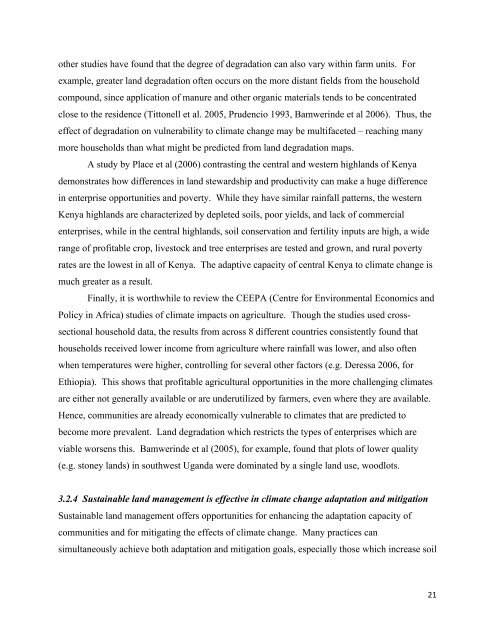The Role of Sustainable Land Management for Climate ... - CAADP
The Role of Sustainable Land Management for Climate ... - CAADP
The Role of Sustainable Land Management for Climate ... - CAADP
Create successful ePaper yourself
Turn your PDF publications into a flip-book with our unique Google optimized e-Paper software.
!<br />
other studies have found that the degree <strong>of</strong> degradation can also vary within farm units. For<br />
example, greater land degradation <strong>of</strong>ten occurs on the more distant fields from the household<br />
compound, since application <strong>of</strong> manure and other organic materials tends to be concentrated<br />
close to the residence (Tittonell et al. 2005, Prudencio 1993, Bamwerinde et al 2006). Thus, the<br />
effect <strong>of</strong> degradation on vulnerability to climate change may be multifaceted – reaching many<br />
more households than what might be predicted from land degradation maps.<br />
A study by Place et al (2006) contrasting the central and western highlands <strong>of</strong> Kenya<br />
demonstrates how differences in land stewardship and productivity can make a huge difference<br />
in enterprise opportunities and poverty. While they have similar rainfall patterns, the western<br />
Kenya highlands are characterized by depleted soils, poor yields, and lack <strong>of</strong> commercial<br />
enterprises, while in the central highlands, soil conservation and fertility inputs are high, a wide<br />
range <strong>of</strong> pr<strong>of</strong>itable crop, livestock and tree enterprises are tested and grown, and rural poverty<br />
rates are the lowest in all <strong>of</strong> Kenya. <strong>The</strong> adaptive capacity <strong>of</strong> central Kenya to climate change is<br />
much greater as a result.<br />
Finally, it is worthwhile to review the CEEPA (Centre <strong>for</strong> Environmental Economics and<br />
Policy in Africa) studies <strong>of</strong> climate impacts on agriculture. Though the studies used crosssectional<br />
household data, the results from across 8 different countries consistently found that<br />
households received lower income from agriculture where rainfall was lower, and also <strong>of</strong>ten<br />
when temperatures were higher, controlling <strong>for</strong> several other factors (e.g. Deressa 2006, <strong>for</strong><br />
Ethiopia). This shows that pr<strong>of</strong>itable agricultural opportunities in the more challenging climates<br />
are either not generally available or are underutilized by farmers, even where they are available.<br />
Hence, communities are already economically vulnerable to climates that are predicted to<br />
become more prevalent. <strong>Land</strong> degradation which restricts the types <strong>of</strong> enterprises which are<br />
viable worsens this. Bamwerinde et al (2005), <strong>for</strong> example, found that plots <strong>of</strong> lower quality<br />
(e.g. stoney lands) in southwest Uganda were dominated by a single land use, woodlots.<br />
3.2.4 <strong>Sustainable</strong> land management is effective in climate change adaptation and mitigation<br />
<strong>Sustainable</strong> land management <strong>of</strong>fers opportunities <strong>for</strong> enhancing the adaptation capacity <strong>of</strong><br />
communities and <strong>for</strong> mitigating the effects <strong>of</strong> climate change. Many practices can<br />
simultaneously achieve both adaptation and mitigation goals, especially those which increase soil<br />
!<br />
%$!

















